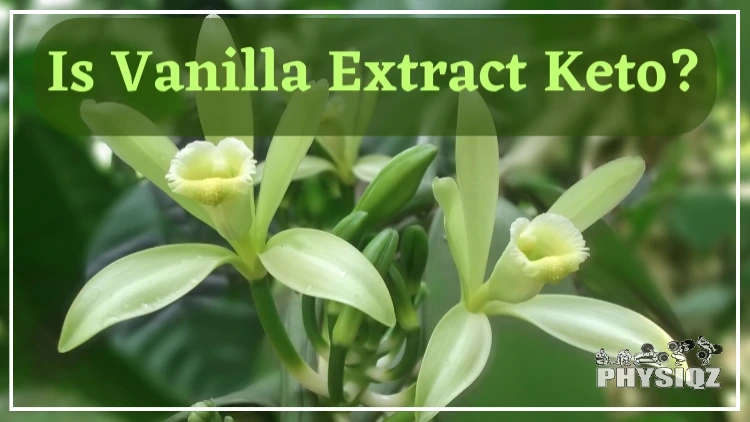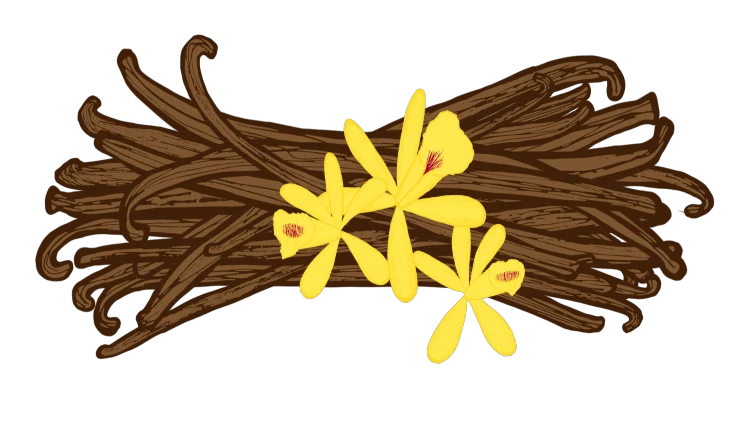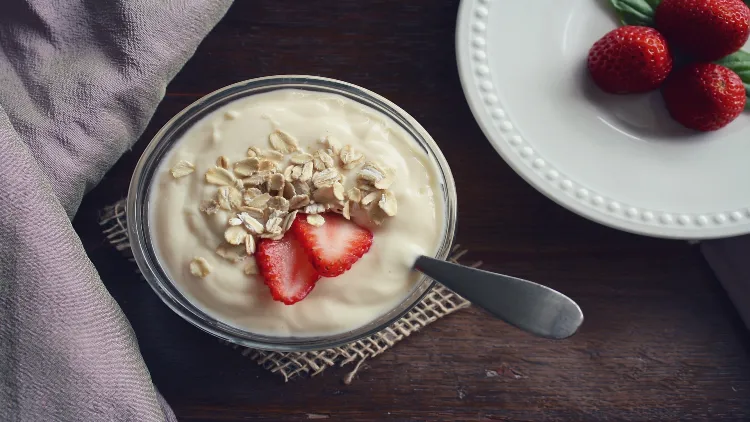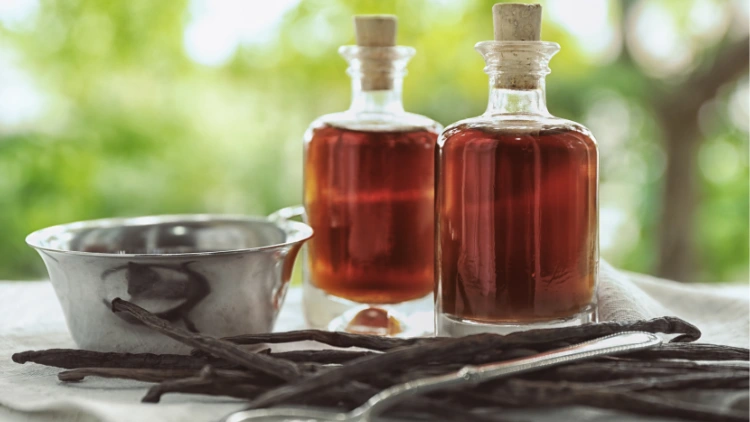
Determining whether or not vanilla extract is keto approved comes down to the amount of carbs are in the extract and while it is acceptable on a keto diet, the nasty truth is that some vanilla extract types are sourced from beaver excretions, have harmful carcinogens and contain other not-so-healthy ingredients.1
While some types of vanilla extract have shocking ingredients, we’ll provide some alternative safe, ketogenic, pure vanilla extract brands to opt for instead and offer a vanilla extract recipe to try yourself.
The Nasty Truth About Extract Types That Often Goes Unnoticed (Imitation Vanilla Risks)
Pure vanilla extract that’s been approved by the U.S. Food & Drug Administration (FDA) is much safer than imitation extracts that intentionally add problematic ingredients to cut costs and maximize profits.
Before we discuss what castoreum is and why to watch out for it–and which other ingredients companies often add to their so-called “natural” vanilla extract–let’s cover where truly pure vanilla comes from.2

Source: ArtRose from Pixabay3
Used to flavor everything from cakes, ice creams and coffees to cigarettes, lip glosses and perfumes, vanillin is harvested from a plant called vanilla planifolia–the vanilla orchid that produces long flat “vanilla beans” or pods that hold the spice we simply call vanilla.4
Since the flower of the vanilla planifolia opens for merely a few hours to be pollinated naturally by bees or risks being deemed useless by harvesters, many companies that sell commercial vanilla have begun having workers hand-pollinate these plants for a higher success rate and–again–to capitalize on profits.
With that in mind, let’s get into the issues with highly processed vanilla extract and why imitation extracts should be avoided.
Harmful Carcinogens
In the mid-1800s, vanillin farmers were already realizing the immense amount of land and labor required to produce pure vanilla extract and were seeking alternate production methods for efficiency and cost-savings.
Scientists in Germany found a way to create a synthetic alternative to organic vanillin using compounds from coal; not long after, most companies and households used imitation vanilla instead of its organic counterpart.
By this same time, coal was considered one of many officially labeled carcinogens and was eventually phased out from its role in making artificial vanilla.
However, artificial vanilla still releases toxic chemicals when burned, including polycyclic aromatic hydrocarbons that are classified as cancer-causing agents–probably not exactly what you had in mind when making vanilla cupcakes or homemade ice cream.
Additionally, artificial vanilla is a forest industry by-product, now produced by either chemically synthesizing clove oil, using rice bran extract, or making the extract from lignin–a by-product of the paper manufacturing process. Since the lignin has to be treated with chemicals to get it to taste more like real vanilla, it’s far from natural.5
The inclusion of vanillin for flavoring cigarettes and other tobacco products not only means that it’s burned and releases the aforementioned cancer-causing chemical agents, but that it also makes the flavor and scent of tobacco more desirable.
This means smokers are inhaling higher levels of toxins than when smoking non-vanilla flavored tobacco products and that those who smoke anything vanilla flavored or scented are more likely to develop an addiction.
Beaver Excretions
Few people know what is really in vanilla or what beavers have to do with this flavorful, aromatic extract. There are high costs and a long time frame (up to 6 months from harvesting to completing the curing process) associated with cultivating vanilla naturally from vanilla planifolia.
This has led to the use of alternative methods of producing synthetic or imitation vanilla extract–including through the chemical lignin–a by-product of wood waste.
One might be rather surprised (and perhaps disgusted) to learn that a secretion called castoreum that’s excreted from beaver’s sweat glands to mark their territory is used in some imitation vanilla extracts because it smells and tastes similarly to vanilla. For those wondering where the beaver’s sweat glands are located, we regret to inform you that they are near the beaver’s anus–just between the pelvis and base of the tail, under the skin.
Since the FDA allows for the process of beavers being killed or anesthetized (put to sleep) and their castoreum glands milked by humans to qualify as “natural”, unfortunately any imitation vanilla made with castoreum can be marketed and labeled as “natural vanilla.”6
Those who are put off by this fact may want to opt for pure, organic vanilla to ensure they’re getting vanilla from the orchid without beaver excretion–but it’ll likely cost you a bit more.
Highly Processed
Since nearly all vanillin is now manufactured, those who value clean eating will be disappointed to learn that most vanilla extract is highly processed.
Either made through manmade pollination, refining petrochemicals, chemically engineering fungi or yeast to transform sugar into vanilla flavoring, or using wood industry by-products, unless labeled as certified pure organic vanilla extract by the FDA you can safely assume that all other vanilla is synthetic–and even some labeled as “natural” may be using loopholes so ensure the certification is government-endorsed.
Added Sugars
Pure vanilla extract has only two or three ingredients: vanilla beans, ethyl alcohol, and (sometimes) water. However, many imitation vanilla extracts are made with additional ingredients to make them taste sweeter, richer, or more aromatic.
This enhancement often includes added sugars, which are restricted on many weight loss diets and are definitely not recommended in high doses on keto.

Source: Conor Brown via Unsplash7
If you’re feeling frustrated or impatient on the ketogenic diet and wondering about the amount of time it takes to achieve your ideal body, it’s crucial to steer clear of artificial vanilla options with added sugars to reach your goals as swiftly as possible.
Preservatives
Much of the vanilla extract now produced in Mexico and the Caribbean is artificial, with preservatives such as alcohol, potassium sorbate and corn syrup being added to many varieties. Potassium sorbate can be unsafe for anyone pregnant or breast-feeding, and may also contain trace amounts of lead, arsenic, or mercury due to contamination in processing.
Corn syrup can lead to obesity, heart disease, fatty liver, high cholesterol, and type 2 diabetes.
Dyes
Some artificial vanilla extracts are clear, but pure vanilla is brown in color due to the natural color of vanillin. A clear vanilla extract is guaranteed to be synthetic, but unfortunately you can’t assume that all that are brown are natural either because caramel color and other potentially harmful dye alternatives are often added to synthetic extracts.
Is Vanilla Extract Suitable for Keto?
Those on the keto low carb diet who enjoy vanilla cupcakes or iced coffees may question whether vanilla extract aligns with their dietary guidelines.
While other trending diets may have different allowances, determining the suitability of vanilla extract for keto involves examining its nutrition details. The ketogenic diet requires strict carb limits and emphasizes foods high in fats and proteins.
Let’s see if vanilla extract falls under the umbrella of keto-compliancy.
Carb Content of Vanilla Extract
Pure vanilla extract is suitable for keto because it fits within the daily keto carb limit of 20-50 grams of carbs; with each tablespoon serving size holding just 1.6 grams of carbs and falling at 5 on the glycemic index, vanilla extract–if in its purest form–is ketogenic.
Since so little vanilla is needed in most recipes due to its strong flavor, it’s fine to enjoy on keto–but imitation vanilla extract is still extremely risky due to the aforementioned processing and ingredients and because those added sugars and ingredients can quickly skyrocket the carb count and glycemic index rating and kick someone out of ketosis. Organic vanilla extract is always the best bet.
Is There Any Type of Keto Friendly Vanilla Extract?
There are certainly some keto-friendly vanilla extracts since some artificial options are low carb and it’s guaranteed to be keto-friendly vanilla extract if it’s pure; the main issues are the harmful manufacturing process and ingredients that are often included in synthetically made extracts.
For beginners on weight loss diets like keto, a valuable tip is to carefully check the nutrition labels to ensure they are FDA-approved and labeled as “pure” or “organic” before making a purchase.
Though we’ve covered some drawbacks and dangers of imitation vanilla extracts, pure vanilla has some great benefits; for example, the role of vanillin on cancer development has shown promising results. Several studies revealed vanillin has both antitumor and antioxidant properties, and may be useful in preventing and treating cancer.8
Pure vanilla extract may also aid in reducing inflammation and overall sugar consumption.
4 Safe Ketogenic Pure Vanilla Extract Brands
Vanilla extract is not just keto-friendly; it’s safe when pure and unprocessed. Let’s check out some of the best pure vanilla extract brands and varieties.

Source: Aline Ponce via Pixabay9
1. Simply Organic
This brand offers organic vanilla extract from premium Madagascar bourbon vanilla beans, grown and harvested by small-scale farmers who ensure environmentally friendliness and great quality. Their pure vanilla extract is gluten-free and has no added sugars, flavors, or artificial ingredients.
Simply Organic has also given over $1.5 million to promoting organic projects and ending food insecurity.
2. Kirkland
Kirkland’s signature pure vanilla extract is made with only vanilla bean extractives in water and alcohol, listing no added sugars, preservatives, or other ingredients so this is a keto-approved option for all of your vanilla flavoring needs.
3. McCormick
Offering an all natural pure vanilla extract with no added ingredients or dyes, McCormick boasts a “premium pure vanilla bean extract with a deep, rich taste and color” that’s gluten-free and non-GMO. This is great for baking desserts, pastries, or adding to coffee.
4. Native Vanilla
This brand offers an aromatic, flavorful vanilla extract that’s certified organic, kosher and vegan. They’ve excluded all dyes, preservatives, sugars, and additives for a clean extract that won’t bump you out of ketosis.
Imitation Vanilla Extract Brands To Avoid
Now that we’ve covered some environmentally and safer ketogenic pure vanilla extracts to choose from, here are several imitation vanilla extract brands to avoid and the reasons to stay away from these options if you’re trying to maintain ketosis.
1. Nielsen-Massey
This Madagascar vanilla extract is marketed as “bourbon pure vanilla extract” but has added sugars in their ingredient list, so isn’t truly pure organic extract. This highlights the importance of checking labels since their marketing is misleading.
2. Watkins Clear Vanilla Flavor
This product is visibly impure by its clear color, as no pure vanilla extract is clear. This is a sign of being highly processed and gets even more problematic when we look at the ingredients; it includes both sugar and propylene glycol.
Propylene glycol is a colorless liquid that’s often used to maintain moisture in medicines, cosmetics, and food products but can cause gastrointestinal issues, nausea, and headaches in some who ingest it and skin irritation when used externally.
3. Baker’s Imitation Extract
Baker’s imitation extract includes far more ingredients than pure vanilla extract; this brand adds propylene glycol, caramel color, sodium benzoate (a preservative), phosphoric acid, and ethyl vanillin (a manufactured replica of natural vanillin). All of these additives make Baker’s brand a poor choice for keto and for general health.
4. Molina Vanilla Blend
Beware of any advertised “blends” as these are guaranteed not to be pure. Molina’s vanilla blend includes propylene glycol, caramel color, ethyl vanillin, preservatives, artificial flavors, and potassium hydroxide which itself can cause a slew of health issues.
Make Your Own Safe & Pure Vanilla Extract (Easy Vanilla Extract Recipe)
By making your own vanilla extract, you can ensure it’s pure and enjoy the satisfaction and achievement of making it yourself–not to mention not having to wonder if vanilla extract is ketogenic when you’re the one making it. Keep in mind it takes months to be fully ready but if you’re in it for the long haul we have the perfect recipe for you.
Remember that the amount of weight you can lose on keto is influenced by various factors such as starting weight, goal weight, mobility, and eating habits. Ensuring you eat clean is a highly effective way to accelerate your weight loss journey, making crafting your own pure extract a fantastic option.
Ingredients:
- Vanilla beans (1 bean pod per ⅓ cup of alcohol)
- Vodka
Instructions:
Step 1: Gather vanilla beans and vodka; you can use as much or as little as you’d like, but ensure that you have enough of each for keeping the 1 bean pod to ⅓ cup of vodka ratio; have sealable jars or bottles ready
*Madagascar, Mexican, and Tahitian vanilla beans are all great options for making extract
Step 2: Using a paring knife, split each vanilla bean in half, leaving the ends of each intact
Step 3: Drop opened vanilla beans into a clean and resealable glass jar or bottle
Step 4: Pour in ⅓ cup vodka per bean over the pods and seal the lid tightly
Step 5: Store the jar(s) or bottle(s) somewhere cool and dry for 4-12 months; shake every week or two and keep in mind that the longer you wait, the more potent your vanilla extract will be
Step 6: After months of waiting, enjoy the fruits of your labor and patience and try out your own homemade pure vanilla extract!
Note: bourbon, brandy, or rum can be used instead if their added flavor profile is desired, but vodka is best for getting the strongest vanilla taste

Source: pixelshot via Canva.com10
All government endorsed pure vanilla extract is keto-approved, as it only contains vanilla bean pods, alcohol, and sometimes water. However, ensuring that vanilla extract is keto-friendly isn’t the only consideration; be sure to check the ingredients and organic certification too.
Frequently Asked Questions
Does Vanilla Extract Contain Sugar?
Those questioning does vanilla extract contain sugar should know that pure vanilla extract doesn’t, but many “blends” or “flavorings” have added sugars so always be sure you’re buying sugar free vanilla extract.
Is McCormick Vanilla Extract Keto Friendly?
One great option for an organic vanilla extract is McCormick vanilla extract; keto-friendly and with additive-free, this is one of our recommended brands.
Is Trader Joe’s Vanilla Extract Keto Approved?
For anyone curious is Trader Joe’s vanilla extract keto-approved, Trader Joe’s sells an alcohol-free vanilla extract but they’ve added sugar cane and glycerine so those on keto should pass.
Does Vanilla Extract Have Calories?
To clarify, does vanilla extract have calories: yes, 38 calories per tablespoon serving.
Is Imitation Vanilla Extract Keto Friendly?
Unfortunately the answer to is imitation vanilla extract keto friendly is no; since most imitation extracts contain preservatives, dyes, added sugars, and even harmful ingredients, most are non-ketogenic; opt for pure FDA-approved vanilla extract instead.
Is Vanilla Extract Keto and Safe in Certain Brands or Pastes?
Vanilla comes in extract form and pastes; some vanilla paste is keto-approved, but be sure to check the nutrition label for the carb count to be sure.
References
1bineshab. “Plants in Nature.” Canva, Accessed 5 April 2023. <https://www.canva.com/photos/MADQ5otJ7PQ-plants-in-nature/>
2Wikipedia the Free Encyclopedia. (2023, January 4). Castoreum. Wikipedia. Retrieved March 4, 2023, from <https://en.wikipedia.org/wiki/Castoreum>
3ArtRose. “Vanilla Pod Flower – Free image on Pixabay.” Pixabay, 23 May 2020, Accessed 5 April 2023. <https://pixabay.com/illustrations/vanilla-pod-vanilla-flower-5204919/>
4Health: Government of Malta. (2021). Vanillin. health.gov.mt. Retrieved March 4, 2023, from <https://deputyprimeminister.gov.mt/en/environmental/Pages/Policy-Coordinating-Unit/PITOC/Vanillin.aspx>
5Crick, J. (2017, January 11). Vanilla is a forest industry by-product. Michigan State University Extension. Retrieved March 4, 2023, from <https://www.canr.msu.edu/news/vanilla_is_a_forest_industry_by_product>
6The Evergreen State College. (2023). What Do Beaver Butts and Vanilla Have in Common? Plant Profiles in Chemical Ecology. Retrieved March 4, 2023, from <https://sites.evergreen.edu/plantchemeco/whats-really-in-vanilla/>
7Conor Brown. “cupcakes on wooden surface photo – Free Vanilla Image on Unsplash.” Unsplash, 28 August 2019, Accessed 5 April 2023. <https://unsplash.com/photos/0zlrKSe1TUs>
8Bezerra, D., Soares, A., & de Sousa, D. (2016, December 19). Overview of the Role of Vanillin on Redox Status and Cancer Development. Oxidative Medicine and Cellular Longevity. <https://www.ncbi.nlm.nih.gov/pmc/articles/PMC5204113/>
9Ponce, Aline. “Yogurt Strawberries Food – Free photo on Pixabay.” Pixabay, 8 June 2016, Accessed 5 April 2023. <https://pixabay.com/photos/yogurt-strawberries-food-fruit-1442034/>
10pixelshot. “Bottles with Aromatic Vanilla Extract on Table.” Canva, Accessed 5 April 2023. <https://www.canva.com/photos/MAD9bvb6-VU-bottles-with-aromatic-vanilla-extract-on-table/>